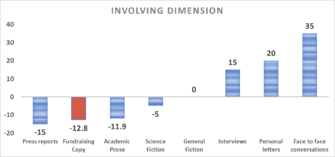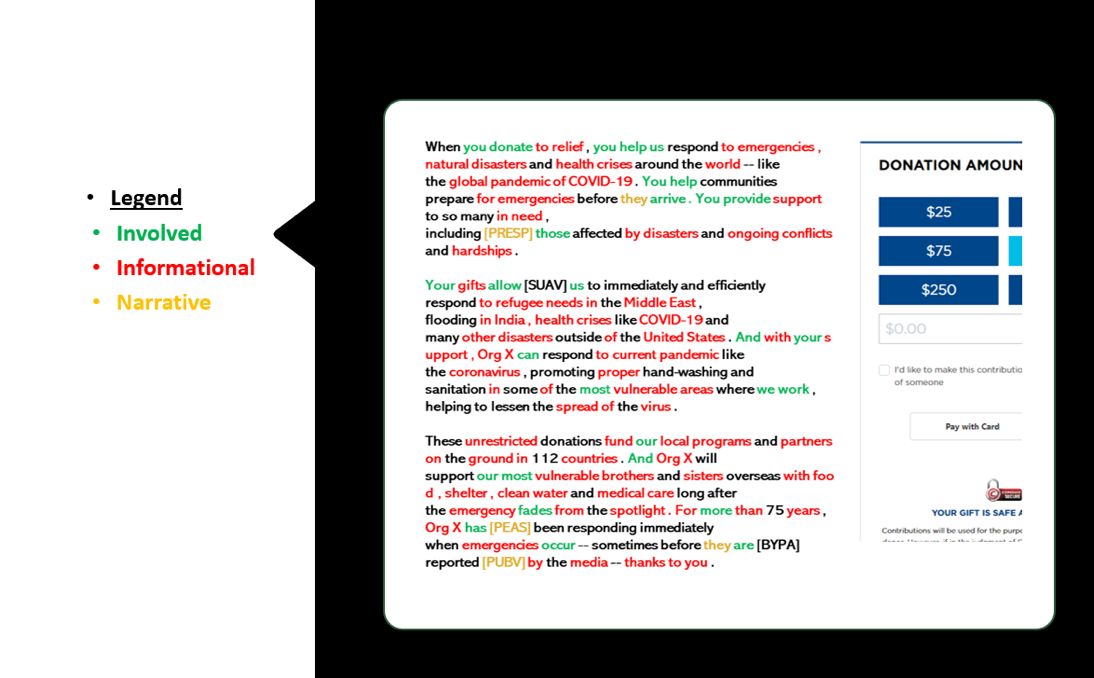What Makes for Good Fundraising Copy?
At its core, it’s words. Google thinks an email is ‘good’ – meaning they don’t bury it in a spam or promotion or social folder – if it reads like something you’d get from a friend, something that sounds personal and involving based (in part) on the words used.
And what about those “personal” and “involving” words that tell a story? There’s an entire field in psychology called “narrative psychology”. These academics know our memories are not chronological encyclopedias but rather, stories. They’ve found that personal, narrative arcs where challenge gives way to triumph (i.e. redemption stories) are common in highly generative adults; adults who have a desire to provide for future generations and make the world a better place. These same people who tell redemption stories also tend to be happier.
This sounds an awful lot like what we’d want to achieve with a fundraising letter, doesn’t it? A redemption story that compels people to want to make the world a better place and make themselves happier in the process.
If personal and involving narrative, stories are the aim, they must have an opposite. “Good” only exists if “bad” exists.
Fortunately, we needn’t guess at this. Linguists long ago cracked the code on how the words we use fit on certain dimensions. And while their work took decades and involved some semi-sophisticated multivariate analysis, the core is rather simple and intuitive. Certain parts of speech tend to group together and be associated with different types of writing.
Formal nouns, for example, are often found in informational and “dense” communication, like academic journals. On the other end of the informational and dense continuum are face to face conversations and personal letters that tend to contain far fewer nouns and more contractions, present tense verbs and 2nd and 1st person pronouns.
This Involving Dimension – Involving vs. Informational – is important in diagnosing whether your copy has a chance of connecting with people or burying them in mind-numbing facts they’d find (and not read) in a boring journal. These scores aren’t random, far from it. And unfortunately, neither is the negative 12.8 score for a broad cross-section of fundraising copy analyzed by a PhD candidate for his thesis back in 2008/09 that comprised 1.5 million words and 880 charities across 9 sectors.

(Enlarge image)
The same holds for the 2nd dimension that is used to measure, score and compare communication on whether your copy has story-telling narrative qualities or, per the sector analysis, reads more like an academic abstract.

(Enlarge image)
Fortunately, there is a way to score any specific communication or copy, measure where it sits on these two critical dimensions and more importantly, get diagnostic feedback.
Sneak Peak: The Copy Optimizer
Here at DonorVoice we call this analytic tool The Copy Optimizer and it’s currently a pre-alpha product, available to Agitator readers for testing.
Imagine your web donation forms (example shown) or e-appeals or direct mail letters being instantly audited and scored and diagnostically broken down, word by word.

(Enlarge image)
Product Road Map
We aim to create a DIY online utility where you can upload your copy and, in return receive an analysis and recommendations for improvement. Copy Optimizer will be publicly available on the web and also on CRMs with content editing functionality.
We’re now at work with Roger and a team of veteran copywriters and engineers on the Beta and launch version. This version will include prototypes of great (meaning high performance) fundraising copy and lots of other instructional guidance aimed at taking you from diagnostic audit to editing your copy for optimum performance.
So far in reviewing a variety of fundraising communications we’ve seen over-reliance on nouns, prepositions and long words plus attributive adjectives (bright morning, mysterious event) that make for dense, informational reading and not enough private verbs, contractions, emphatics, (“be” as a main verb), wh questions (and many others) that signal more personal, involving copy
You Are Invited to Participate
At this pre-alpha product stage, the opportunity for Agitator readers is the following:
- Send us the first page from two different, house file mailings, one that did well and one that did poorly
- Include the response rate for each letter/package
- Plain text (Word is fine), not pdf
- Non premium packages
- No matching gift offers or other tactical approaches
- We’ll provide scores, comparisons and diagnostic details
- First 15 qualifying submissions will be reviewed – so don’t wait…
Please send it directly to me at kschulman@thedonorvoice.com
Writing good fundraising copy may be art to the tiny, handful of writers with formal education and training or gifted by the Gods but as our early analysis and the prior work of academics shows, we ain’t Lake Wobegon. Humility dictates each of us assume our copy needs a lot of work and it requires much more than simplistic pronoun counts or other, skim-the-surface counsel or platitudes about ‘telling a story”, “making it emotional” or using simple words and avoiding jargon.
How effectively organizations communicate matters. A lot. We plan to beat this drum quite a bit over the coming months. Our aim is to provide a science-based tool that delivers the kind of “under-the-hood” detail and comparative benchmarking you need to improve performance while still making it user-friendly, real-time and as simple as possible.
We welcome your participation and input as we undertake this initiative.
Kevin



This will be so cool!
Thanks Steven. We’ll be looking to integrate this with CRMs that provide publishing functionality for email, social and mail. and Bloomerang is certainly on the list. In the meantime, feel free to submit a Bloomerang client letter or two.
Very excited about The Copy Optimizer. I love breaking down narrative language to examine how it prompts action, connection, and response. This speaks so deeply to my inner writing nerd.
Stephanie, glad to speak to any inner nerd, if this fundraising profession needs anything it is more nerds. Damn near every field I can think of from sports to finance has been positively infiltrated by more nerds providing more nuanced, rigorous, objective perspective, understanding and analysis. Fundraising is a laggard in this way.
So exciting! What a huge contribution this will be to the sector. Can’t wait to see it in action.
Thanks Claire, we certainly hope so
We’ll send in a thing or two… For one client in particular who dislikes when our copy sounds too familiar! Looking forward to the evaluation.
Karen, been a long time, hope all is well. Yes, please do send to me (sooner the better). Familiar is key requirement for “involving”, personal writing, which is part of the key to success, narrative storytelling being the other. THey are stylistically different and use very different parts of speech and we’ll score on both factors.
Thanks.
will do! Probably will come from my colleagues. Thanks Kevin!
So exciting! Especially the thought that fundraisers will have a tool like this and do better. Thank you!
This is so great! And I recognize the donation form :). I’m in – will send some copy. I’m curious about the scoring and is “informational” a negative thing? I was wondering why the phrase “thanks to you” was informational – is it because that’s just informing the donor (thanks to them…)? And was the scoring more based on the word use and less on the type of language?
thank you!
Hi Larissa. Good to hear from you and hope all is well. I’m planning to come to the next in-person meeting at your HQ, whenever that is… Until then, zoom. We look forward to going through all of this in detail with you, please do send letters with response rate (good and bad) and if you like email appeals (with response rate) as well.